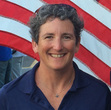Carol Newman Cronin's Blog, page 22
September 23, 2021
Voice: I Know It When I See It
Like most of you, I follow several blogs. In my case, it’s an odd mix of high-level sailing news and stories about, well, story. There are also plenty of blogs I don’t follow; they probably contain great information, but they lack a certain consistency in presentation and tone.
The writing world calls this consistency “narrative voice.” (It’s a bit different from authorial voice, which I’ve written about before.)
 Strong Like Bull
Strong Like BullThe books I finish always have a strong voice, too. Fiction or non, regardless of subject matter, that’s the key to keep me turning pages. Without a personality to hold it all together, my mind begins to wander and I soon put down the story. (Unless it’s for book group, of course.)
Narrative voice has famously been described by agents and editors as “I know it when I see it,” because it’s very hard to pin down. Using only the simple building blocks of word choice and order, it has a lot of work to do: first and foremost, it must conjure up a world that we can “see” on the big screen between our ears. Next, it has to make us care what happens in that world, usually by introducing a main character in some sort of trouble. It also has to include just the right level of detail; too many will distract us from the big picture.
Then, once this voice has us hooked, it has to continue to do all that stuff in a similar and consistent way, all the way to The End. Novels most often disappoint somewhere about a quarter to a third of the way through; right where the editor ran out of time, or decided the rest was good enough. Because usually it’s the editor who polishes the narrative voice into something consistent enough to be trustworthy.
But Subtle, TooWhen I lose myself in a good story, I usually forget that there is a narrator who is distinct from the point of view character. Sometimes it’s obvious, of course—narrators talking about their characters as if looking down from a great height. But the stories that really grab me have a narrator who keeps the POV characters so close, it’s easy to think they are one and the same—until that key detail is dropped in, something the character wouldn’t comment on, which we need to “see” because we’re not actually in that world. Narrative distance can make the difference between understanding what’s going on and getting lost. But too much space between a narrator and the story usually comes off as cold, and who wants to read a cold story?
There are countless conscious and unconscious choices that go into a strong, consistent, voice, and I definitely “know it when I read it;” the much bigger challenge is to create that same narrative voice in my own writing. Selecting the right detail will help the reader “see” the scene I’m building, but just stringing together bits of information isn’t enough; it also has to make you care what happens next.
Sailing blog, writing how-to, magazine article, or book; the only thing that will keep me reading all the way to The End is narrative consistency. In other words—it’s all about the voice.
Need an Example?Below are six sentences, picked at random from—yes, the early—pages of Ferry to Cooperation Island. I’ve bolded the text that is included by the narrator for reader clarity; James wouldn’t need to explain any of it to himself.
Nobody knew why Joe’s ancestors had chiseled granite blocks and piled them into a square-edged ten-foot tower. It had already stood up to a hundred years of hurricanes and winter gales—as well as the kids, both native and white, who’d tried to climb it. James leaned against the outside face, where he’d be hidden from any passersby. Not that too many people came down this way, now that the island’s tribe had dwindled to three. He could breathe here, think things through…
But before he could find any answers, a woman’s voice interrupted.
Got a good example of a strong, consistent, narrative voice? Share it in the comments below, or send me an email. And thanks for reading, all the way to The End!
The post Voice: I Know It When I See It appeared first on Carol Newman Cronin.
September 9, 2021
Cuttyhunk Cruise, Meet Overactive Imagination
A few weeks ago, we sailed out to Cuttyhunk to meet up with some cruising buddies. I have a lot of childhood memories from this outermost of the Elizabeth Islands, and we’ve often stopped overnight on more recent sails to Woods Hole, but I hadn’t actually stepped ashore for several years. Surprisingly, both pale macadam and dirt road felt instantly familiar underfoot, because they reminded me of a place where I’ve been spending a great deal of time: Cooperation Island. My overactive imagination must’ve quietly tucked away a long list of sensory details, just in case I ever needed to describe a New England island—and then delivered them up as if “new” and somewhat unformed, their origins forgotten.

Three examples:
A clamshell driveway as crunchy white as the Brenton Bean’s parking area.The 360 degree view of Buzzards Bay and Vineyard Sound from the top of the hill: just as unobstructedly beautiful I remembered. What I didn’t recall was a newer-looking building halfway down the southeast slope; it seemed a bit oversized for the island—and had exactly the same “witch-hat” dormers as the Skye View Inn. Hmm.Paddling out through the harbor entrance just after sunrise, I spotted a series of rocks that stepped out from the shoreline—each one topped by a cormorant drying its wings. Though I could easily see the buoy that marked deep water, I could almost smell Courtney’s fear when she first approached Brenton Harbor: “She’d just started to think she was home free when she spotted a string of rocks dribbling out into the channel, the outermost one topped by a cormorant with black wings spread like judge’s robes.”Cooperation Island wasn’t consciously modeled on Cuttyhunk, and many of its location details were created just to suit the story. But on all of those previous visits, as I joyously ambled along pale macadam and darted down dirt roads, my novelist’s eye had obviously been toiling away in the background—where it does its best work. Filing away pesky details about how an island “should” look and feel, so that I could later describe to others what my imaginary island “actually” looks and feels like.
We only stayed for one night, but as I watched Cuttyhunk fade away astern, I realized how relaxing even such a short cruise had been. On a real island, there was no need to try to put everything I was seeing into just the right words—because everyone else could see it too. And even though not every detail was exactly the same as I remembered, it was all, somehow, just exactly right.
The post Cuttyhunk Cruise, Meet Overactive Imagination appeared first on Carol Newman Cronin.
September 2, 2021
Hurricane Personalities
Note: I’m writing this a few days after Hurricane/Tropical Storm Henri hit Rhode Island, and I’m hoping it will seem a bit dated by the time you read it. Because that would mean that we don’t have another storm on its way…
I’ve done a lot of thinking, reading, and fabricating around details of the Great Hurricane of 1938 (for Oliver’s Surprise) and 1954’s Hurricane Carol (for Cape Cod Surprise). But it wasn’t until halfway through “le Dimanche d’Henri” (the Sunday of Henri) that it occurred to me how much distinctive personality each storm has. This guy arrived almost 30 years to the day after Hurricane Bob, the last hurricane to make a direct hit on New England, but it developed well north of the usual Caribbean track. So right from the get-go, Henri challenged our pre-conceived notions about how an August storm “should” behave.
Thanks to great forecasting, we had plenty of time to pull boats and tidy up the yard. Henri couldn’t quite make up his mind exactly which coastal town to visit first, but like many Rhode Island visitors he eventually settled on a Block Island landfall. That meant our strongest breeze came out of the east—putting us on the sheltered side of Conanicut Island.
 Several boats went on the rocks on the windward (east) side of Conanicut Island; 5 are visible in this photo (courtesy Suzy Leech).
Several boats went on the rocks on the windward (east) side of Conanicut Island; 5 are visible in this photo (courtesy Suzy Leech). The rain began before dawn on Sunday morning, but the wind didn’t really start whistling until after breakfast. Even at the height of it we were able to sit on our front porch, tracking every wobble on our favorite radar app while simultaneously bracing for the next cracking tree limb. Just after noon, the breeze peaked at about 60 knots and Henry made his second stop in Westerly, RI. Our power went out, but the backup generator was ready to go. With both boats and ourselves well out of harm’s way (and the hurricane libations staying chilled), there was nothing more to do than track the radar and watch the wind shift right.
By early afternoon, Henry had taken his predicted jog west into Connecticut, and without the fueling warmth of Gulf Stream waters, he quickly faded away to something much less serious. Once the puffs dropped down to the 20s, we joined our neighbors in a checkup around the island. Not everyone had been able to move their boats to a safe location, so for some Henri brought the sailing season to an early close. For others, he brought overtime; chain saws, bucket trucks, and backhoes started up to clear the mess he left behind.
While I will probably incorporate some of Henri’s personality quirks into future stories, my primary takeaway is something all hurricanes have in common: the timeless power of community. No matter how different storms might be, they all give us a common focus. For four days (before, during, and after), neighbors and visitors alike paused to discuss preparations, power outages, tree damage, and when more typical summer activities like sailing and swimming could safely resume. We don’t need the big-picture view of radar to appreciate that.
By the time you read this, I’m hoping that Dimanche d’Henri and hurricanes in general are no longer our main topic of neighborhood discussions. But I also hope that our renewed sense of community and common goals remains, long after the chain saws and backhoes and bucket trucks have gone quiet again.
The post Hurricane Personalities appeared first on Carol Newman Cronin.
August 26, 2021
August, Die She Must
Fair warning: this title, borrowed from Simon and Garfunkel, captures exactly what I’m going to try to explain here, and it does so in only four words—while I will undoubtedly use many more. (If you want to stop reading right now, feel free.)
But even if they’ve already captured the concept, August deserves more attention than that. The summer equinox may be when the sun actually starts setting and rising later, but this is the time of year when we are forced to accept the reality: summer is winding down. It’s when we remember all those still-undone February dreams, accepting that we won’t actually fit in absolutely everything we had planned—because part of the joy is slowing down and savoring, rather than madly rushing from one exciting thing to another.

This year I started August in Hawaii, because I could still taste the regrets of 2012; Paul came home right after the Pacific Cup, and we both realized it had been a missed opportunity to linger afterward. That’s why I abandoned a New England summer in its prime for ten days in a year-round tropical paradise.
Oahu locals have summer weather year-round, so perhaps August isn’t quite so valuable to them—at least for those of us who don’t have to go back to school in September. But even under a tropical sky, Simon and Garfunkel’s words still rang true. August won’t last forever no matter where we spend it.
Back home again, the burning question this time of the year is: how to fit it all in? Evening sails, while the sunset is still late enough that we don’t have to rush back to the mooring. Weekend cruises. After-paddle swims. Lazy Sundays on the porch, or in a shaded cockpit. So many pleasures, so few days left. All we can do is pack each one chock-full of what we love best—and put off until the fall anything that can possibly wait.
Here’s to August!
(And thanks for continuing to read, even if I’m not as efficient with my words as Simon and Garfunkel.)
The post August, Die She Must appeared first on Carol Newman Cronin.
August 19, 2021
Tokyo 2020ne: Inspirational Magic
Did you watch the Tokyo2020ne Olympics? Different and strange as predicted, but the inspirational magic still came through. As onsite reporter Linda Holmes put it in What I Learned From Watching Every Sport At The Tokyo Olympics, it was “a whole host of unfamiliar worlds in which people work harder than many of us can imagine to build toward a moment that, for many competitors, will only come once and will not result in any glory, or any real money, at all.”
(I would edit that to: for most competitors.)
I was lucky enough to watch the sailing live while sipping sundowners in Hawaii, and boy howdy has coverage improved since my own Olympic adventure in 2004. Though Gary Jobson covered sailing at both events, this year’s mix of perspectives (drones, multiple boat-mounted cameras, and tracker graphics) made it possible to follow what was happening in real time. Gary achieved just the right level of excitement no matter who was winning, and (even more impressively) managed to sustain that excitement for an hour at a time—while basically locked in a closet right through the Connecticut night, all by himself. Very impressive.
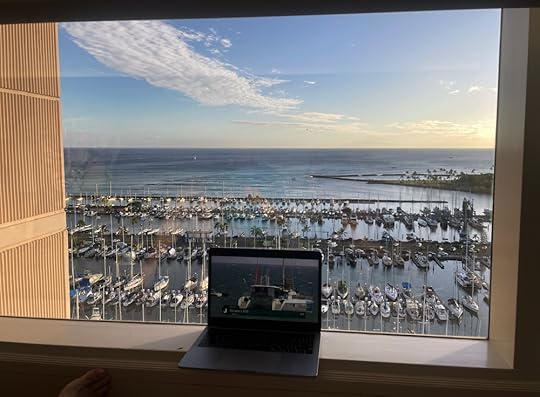
It’s all too easy to over-focus on the ginormous gap between those who climb onto the podium and every other finisher, or get caught up in the behind-the-scenes dramas. But what kept me watching night after night was the simple inspiration and joy of international sailing competition at its highest level. Just getting to the Games requires a strong commitment to excellence in a sport that, for all but a few, will not result in “real money.” All Tokyo2020 Olympians should be enormously proud of doing their absolute best each day on the world stage—especially this time around.
I only had one Olympic experience, but seventeen years later it still inspires me to excel at what I do each and every day—even if that’s just drinking Mai Tais, while watching other sailors work so hard to achieve their own dreams. Thanks to all the athletes, and to Gary for bringing his own unique perspective to this completely different Games.
PS Linda Holmes’ sarcastic reviews of “all the best sports in the Olympics” made me laugh out loud several times. Here’s her assessment of sailing:
I began watching a sailing race early in my Olympic viewing, thinking, “I’m just going to watch this one sailing race, because I have to do some work today.” It took a while for me to realize this Olympic sailing race was going to take about two hours. Many sailing events are not really for those times when you are in a rush. They are contemplative. They are two hours long. Sailing is just like Christopher Cross always said: It takes me away to where I’ve always heard it could be. And by “it,” I mean “watching a sailing race for the rest of the day.”
Read the rest of What I Learned From Watching Every Sport At The Tokyo Olympics
The post Tokyo 2020ne: Inspirational Magic appeared first on Carol Newman Cronin.
August 12, 2021
Aloha Perspective
Those of you who follow me on social media already know that I just got back from Hawaii. The primary reason for leaving home during the best season of the year was to be on the dock to greet Paul when he finished the Transpac (a 2225-mile, 9-day sailboat race from LA to Honolulu). But there were other goals as well: take a real vacation. Get in some serious snorkeling, with reef fish (and, as it turned out, turtles). I’m pleased to say all these boxes were successfully checked, along with a ton of fun dinners and catchups with friends both old and new.
But even months ago, when we first started planning, a more selfish thought underlaid it all: a complete change of scene was just what my writing brain needed. And that’s what I want to try to explain here today: how a fresh Aloha perspective re-opened my creative synapses.
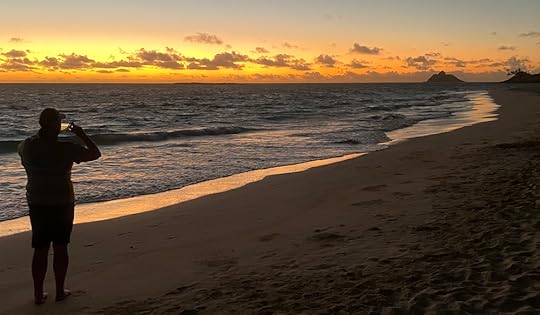
Five years ago, in a post called Filling the Idea Tank, I explained that my best ideas come from getting outside, “hunting and gathering experiences that will eventually form the building blocks of a story.” Though we never lost access to our own outside world this past year, what I now realize is that just wandering around one well-known island on my own isn’t all that’s required to stimulate the creative side of my brain. I also need human interaction—both casual and intentional.
The state of Hawai’i has done a fantastic job of reopening to much-needed tourism while minimizing health risks. Since that distant island chain is about as exotic as Americans can get right now, Honolulu was packed with visitors— and most didn’t have anything at all to do with Rhode Island, writing, or sailboat racing. No matter how early I wandered down to the beach, there were surfers and kiters already catching waves and swimmers already diving into 80 degree water. On one morning swim, I surprised a turtle—but not as much as he (or she) surprised me. It was a totally different atmosphere from home, and just exactly what I needed to reawaken my story senses.
I can’t even track for myself the process that leads from something I spot on a tropical getaway to finishing the next book. Certainly the actual details (waving palm trees, bright blue water, all that mountain greenery) won’t ever fit into a novel that takes place on a rocky New England island. But even though I can’t explain it, the magic has already happened. When I sat down again at my desk a few days ago, my fingers and brain were already working together to weave a new story thread into my WIP. Aloha to my creative writing synapses, and welcome back to life.

It’s a magical alchemy, this spinning of stories. And I wouldn’t want to change anything about it—even the built-in uncertainty of not understanding how it works. It forces me to trust the process I stumbled onto with previous books. And of course, it’s also great incentive to get out of my comfort zone and explore the world, hunting and gathering for story-building stimuli, on whatever beach I happen to find myself.
The post Aloha Perspective appeared first on Carol Newman Cronin.
August 5, 2021
Clicks of Chance: A Profile of Onne van der Wal
The email’s subject line sounded a bit spammy: “Might you be interested?” But the sender was Seahorse editor Andrew Hurst, and he was writing to suggest a story: How Onne van der Wal won the 1981-2 Whitbread Round the World Race onboard Flyer II. “An interview with him about this adventure could be really fun if you may be interested?”
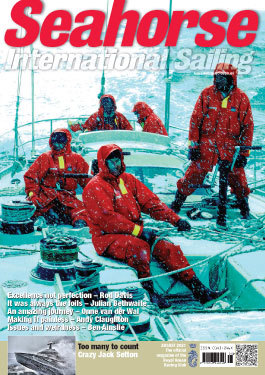
Andrew had no way of knowing that I’d worked with Onne on a few projects over the years. Or that we live only about a mile from each other, on opposite sides of the same island. Fortunately I had time to fit in another fun project, and I knew there would be incredible visuals… so I said yes and set up a lunch date with Onne. The result is attached (and in the August issue of Seahorse).
The term Onboard Reporter hadn’t been coined yet, but that was what Onne did aboard Flyer II—in addition to working the bow and managing the boat’s systems. How it all developed out of a childhood in Cape Town, and why he eventually ended up in Newport, is an example of Seneca’s philosophy: luck is where preparation meets opportunity.
Seahorse has kindly granted me permission to share the article with you—and also extended a special offer to my readers, if you subscribe for a year: 3 months of the print publication for $1! There are also fantastic deals on print+digital and digital only.
Even if you don’t read all my words, click through to enjoy Onne’s dramatic images of what sailing used to look like. (Yes it’s snowing in this cover shot, which was taken long before round the world races had ice gates.) Thanks for reading, and let me know in the comments below or by email if Clicks of Chance makes you want to sail around the world too.
Previous Seahorse profilesJust Say Yes: Stan and Sally Honey
Rod Davis: Why You Need His Wisdom in 2021
Rod Johnstone: An Amazing Legacy of Yacht Designs
A Final Conversation with Harry Anderson
Vince Brun Profile in Seahorse
The post Clicks of Chance: A Profile of Onne van der Wal appeared first on Carol Newman Cronin.
July 29, 2021
Game of Sails: An Olympic Love Story, now in Audio
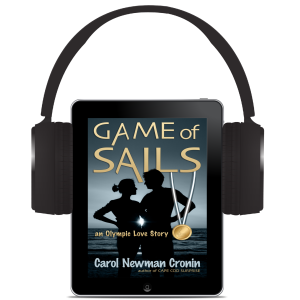
Enjoying the 2020ne Olympics? Me too! Even though this Games is so totally different than what I remember from Athens 2004… which, right now, feels like it was only about seventeen days ago.
But since those heady Olympic days ended I’ve written four novels—and recorded them too! I’m proud to say that all four are now available in audio. So if you’re itching for an Olympics with stands full of screaming spectators (and a soupçon of romance), download the brand-new audiobook version of Game of Sails. You could call it a pandemic project, but I actually put it on the to-do list for the winter of 2020-21 long before that pesky virus reared its worldwide head. Fortunately, thanks to Paul’s excellent soundroom, I was able to complete it without leaving our family bubble.
I do have a few coupons to share that will allow you to listen before making any financial investment. If you’re new to audiobooks, drop me an email and I’ll send you one. If you already have an audiobook app, let me know if Game of Sails isn’t yet available on it—and I’ll try to get that fixed.
And if you’re just not into listening, the ebook is currently on sale for 99 cents—right through the closing ceremonies.
Now, let’s all get back to the wrestling and high diving and—yes, sailing competitions… Let the Games continue!
The post Game of Sails: An Olympic Love Story, now in Audio appeared first on Carol Newman Cronin.
July 22, 2021
Tokyo 2020ne: Sailing’s the Easy Part
“Welcome to the Olympics! Let the GAMES Begin.”
Oh, wait. Will Tokyo2020ne athletes actually hear that most thrilling of all announcements? Who actually says that anyway, and when? Maybe it was at the opening ceremonies? (Or is it just on TV?)
I can’t remember. All I know is that even as the Tokyo2020 postponement flag finally comes down, so many Olympic traditions—all the pomp and circumstance I loved to hate, which today frames some of my strongest memories—will be totally different.
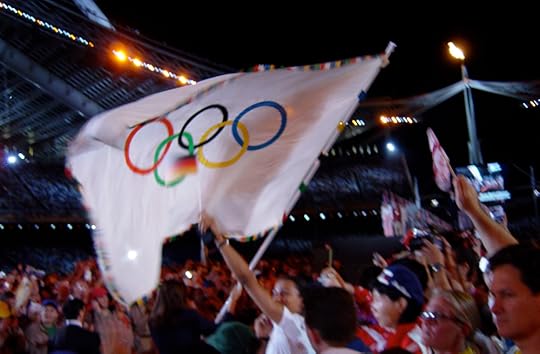
Of course every Games is totally different, because despite the incredibly long list of over-arching rules about branding and behavior and best practices, the host country’s culture always manages to shine through. For Athens2004, the Greeks procrastinated until the very last minute; even as we boarded our buses to the Opening Ceremonies, they were still laying down grass and adding seats to stadiums.
The Japanese prefer to plan ahead and follow the rules—but thanks to a worldwide pandemic, those plans and rules just keep on shifting. So instead they’ve had to constantly pivot and adjust, something the Greeks might have been better equipped to do. No wonder most Japanese citizens would prefer it if these Games didn’t happen; they don’t want to appear on the world stage feeling unprepared.
When I first heard about the most recent rules change—no Olympic spectators—I just shrugged. As a sailor, who cares? All our racing takes place offshore (this time in those massive Enoshima waves, which have rolled across thousands of miles of ocean and are just getting ready to crest onto their first land). In a pandemic-free world, maybe there would’ve been a few devoted family and friends waving flags from the breakwater, or cheering from outside the venue. But unlike more mainstream sports, the only people who actually get to experience Olympic sailing’s actual field of play are those with a job to do: athletes, coaches, officials. No spectators? No problem.
Then I flashed back to my best memory from Athens2004 and thought about how different walking into the opening ceremonies would’ve been without the chanting soundtrack of “USA, USA, USA!” Without standing shoulder to shoulder with so many athletes I’d never met before and would never see again. Without seeing all those cameras flashing in the stands.
(Maybe the inventive Japanese can figure out a way to make mannequins snap photos?)
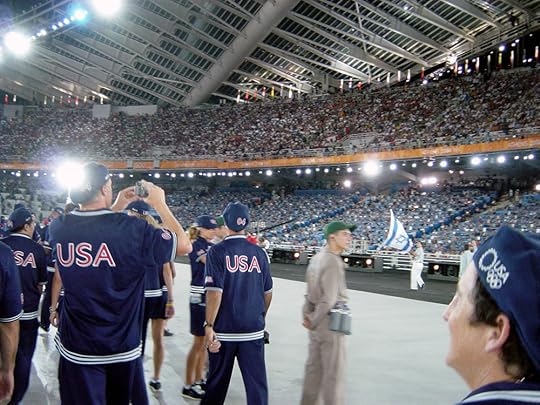
I always say, The Sailing is the Easy Part, and even this year that will still hold true. Once on the water, sailors will adjust the same controls and swallow the same butterflies and jostle for the same hole on the starting line. The field of play will still vary with the weather (how massive will those waves be each day?), something impossible to explain to the non-sailing athletes you meet in the athlete’s village dining hall or on the Team USA bus to the… but wait. This year’s athletes won’t stray that far outside their team bubbles. So all those spontaneous interactions with other sports and other countries won’t be happening either.
Sailors are far better equipped to deal with constantly changing circumstance than athletes who expect their field of play to stay exactly the same from one day to the next. Adjusting sails is, after all, a worldwide metaphor for reacting and pivoting to new information. So I’m absolutely sure that Tokyo2020 sailors will find a way to do their best, despite all the extra variables. There might be a few surprises on the podium—but that’s part of the Olympic allure.
And I’ve absolutely no doubt that the Japanese will be excellent hosts as always, despite their well-founded concerns about a world invasion of their not-yet-mostly-vaccinated island.

Even without a pandemic, Tokyo2021 was always going to be a totally different Games from Athens2004. But I am a bit wistful that so many of my most memorable experiences from seventeen years ago won’t be possible for this year’s athletes. I can only hope that when it’s all over, every single sailor will carry home their own lasting memories of peak performances, friendly competition between nations, and epic ocean waves. If so, it won’t matter how many Olympic traditions get lost in the unexpected uncertainty of Tokyo2020ne. And it certainly won’t matter if anyone actually tells them, “Welcome to the Olympics! Let the GAMES begin!”
The post Tokyo 2020ne: Sailing’s the Easy Part appeared first on Carol Newman Cronin.
July 15, 2021
The Book I WANT to Write
There’s the book I’m writing, the book I will eventually publish… and then there’s the book I WANT to write. Thanks to last fall’s Advanced Novel Planning course, I now realize that those three items are completely different. I’ve always thought through my characters’ motivations—but I’d never before taken the time to consider my own. So now, writing my fifth novel, I’ve finally asked myself: what do I really want to say?
It might seem like a pie-in-the-sky question, but answering it has helped hone the story line. Ten minutes of free-writing on “what story do I want to write” identified two topics that are my primary motivators. More importantly, it also homed in on a subject that I will try to avoid (even as one particularly headstrong character pushes in that direction).
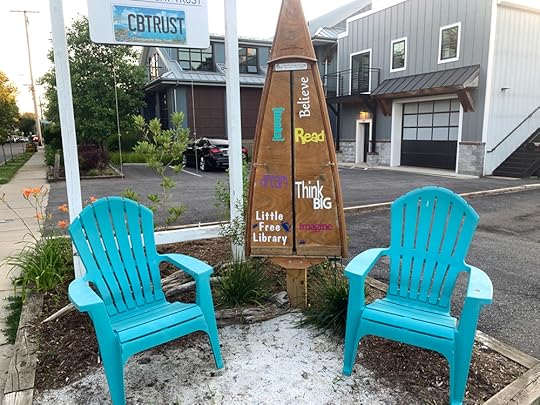
Characters go off track all the time (just like authors). And like real people, the stronger their personalities are, the more determined they are to drag me and the story with them. Such determination is part of their charm, of course—but it can also lead to a word-fest of distraction. Like a good parent, I can steer and direct—especially if I know where we’re headed. It’s a balancing act for sure, and I’ve always erred too far toward a free-range approach.
Like any creative endeavor, novels start off with unrealistic expectations, like: I’ll finish my next book in half the time, and it will contain twice as many ideas. A few years ago, in a post entitled “Next Novel: Work Not Yet in Progress,” I referred to this planning stage as “both terrifying and terribly exciting, the twisted strands that make up pure potential.” Somewhere along the way, of course, those ideas and characters must get winnowed down to only those that serve the “beam” of the story. And an important part of that beam is clarity about the book I WANT to write.
As Story Genius author Lisa Cron puts it, “Creativity needs context. It needs a leash.” Knowing where I want to take us will help get this next book written—though not in half the time, and definitely not with twice the ideas of the last one. I’m certain that this book will end up being quite different than the one I originally set out to write, and I’m also equally sure there will be plenty of surprises along the way. So stay tuned—you’ll be the first to hear my progress updates.
The post The Book I WANT to Write appeared first on Carol Newman Cronin.

